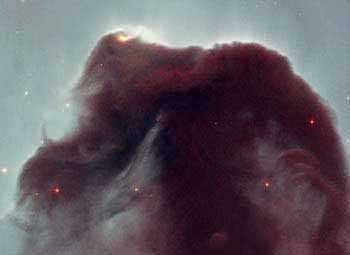Following an internet poll, the scientists photographed the Horsehead Nebula
Avi Blizovsky

The Hal Habel telescope is celebrating a birthday but the astronomer community is receiving the gift. To celebrate the 11th anniversary of the start of its activity in space since it was launched in 1990, it was decided to photograph the Horsehead Nebula. This nebula is a popular target for astronomy enthusiasts and has been chosen by internet surfers over the past year as an astronomical target for the Hubble.
The nebula, also known as Barnard-33, is known for its shape resembling a horse's head, and it was discovered on astronomical photographic film in the late 19th century.
The new photograph of the Horsehead Nebula shows a cold, dark cloud of gas and dust silhouetted against the bright red nebula. This cloud is referred to by scientists as the IC 434 nebula. A bright area in the upper left corner of the image is a young star still surrounded by gas and dust. The radiation from the young star eats away at the gases it was born from. The shadow of another massive star, which is outside the frame of the picture taken by Hubble, carves the top edge of the horse's head.
The Horsehead Nebula lies south of Zeta-Orionis. It shines brightly, and is visible to the naked eye as the left star in a row of three stars that form Orion's belt.
The nebula is a favorite site for amateur astronomers who use it to try their skill at spotting stars. It is known as one of the more difficult objects to observe in an amateur telescope.
The Hubble, currently managed jointly by NASA and the European Space Agency (ESA), was launched from the space shuttle Discovery on April 24, 1990. Two days later, the telescope began operating and has been photographing space and preserving cosmic images ever since.
However, at first he showed unclear pictures. With a huge investment of about half a billion dollars, "glasses" were developed for him that corrected the distortion in his main sight. The repair was carried out in 1993 and since then he began his main scientific work.
We are now in the stages of developing a telescope that will replace the Hubble in about 4-5 years.
During the 11 years of its operations so far, Hubble has circled the Earth 60 thousand times; He has done 2.6 billion kilometers so far; Over 400 thousand exposures of astronomical bodies produced over 6 terabytes of data.
